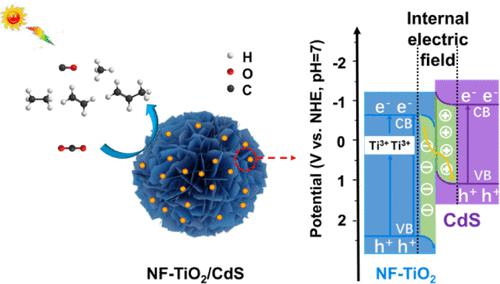当前位置:
X-MOL 学术
›
Ind. Eng. Chem. Res.
›
论文详情
Our official English website, www.x-mol.net, welcomes your feedback! (Note: you will need to create a separate account there.)
Ti3+ Defective TiO2/CdS Z-Scheme Photocatalyst for Enhancing Photocatalytic CO2 Reduction to C1–C3 Products
Industrial & Engineering Chemistry Research ( IF 4.2 ) Pub Date : 2022-06-17 , DOI: 10.1021/acs.iecr.2c01113 Yunxia Bai 1 , Mei Li 1 , Xuemei Liu 1 , Jinyu Han 1 , Xinli Zhu 1 , Qingfeng Ge 2 , Hua Wang 1
Industrial & Engineering Chemistry Research ( IF 4.2 ) Pub Date : 2022-06-17 , DOI: 10.1021/acs.iecr.2c01113 Yunxia Bai 1 , Mei Li 1 , Xuemei Liu 1 , Jinyu Han 1 , Xinli Zhu 1 , Qingfeng Ge 2 , Hua Wang 1
Affiliation

|
Photocatalytic CO2 reduction is a promising route to simultaneously address two critical issues related to the energy and environment. Herein, a direct Z-scheme photocatalytic system, Ti3+ defective TiO2/CdS nanoflowers, was fabricated to enhance the production of C1–C3 products from CO2 reduction. First, nanoflower-like TiO2 (NF-TiO2) is prepared using a TiB2 precursor to build in Ti3+ defects. Then, the NF-TiO2/CdS heterojunctions are constructed via the sulfurization of TiO2/Cd-MOF. Importantly, the optimal heterojunction photocatalyst NF-TiO2/CdS0.6 exhibits a highly promoted CO2 reduction activity not only for CO and CH4 but also for C2–C3 hydrocarbons. The cumulative yields of CO and CH4 are 1007.0 μmol/g and 83.5 μmol/g (2.5 h), respectively, and a yield of 55.3 μmol/g (2.5 h) of C2–C3 hydrocarbons is obtained. This enhanced yield of C1–C3 products is attributed to the synergistic effects of abundant Ti3+ defects that increase adsorption and activation of CO2, the large surface area that provides sufficient active sites, and a direct Z-scheme heterojunction with a good intimate contact interface that effectively separates charge carriers and accumulates electrons with strong reducibility. Moreover, the photoluminescence analysis of hydroxyl radicals was conducted to provide evidence for the direct Z-scheme mechanism. This work provides a facile method for the construction of a TiO2-based direct Z-scheme photocatalytic system for improving photocatalytic performance toward CO2 reduction.
中文翻译:

Ti3+ 缺陷型 TiO2/CdS Z 型光催化剂用于增强光催化 CO2 还原为 C1–C3 产品
光催化CO 2还原是同时解决与能源和环境相关的两个关键问题的有前景的途径。在此,我们制备了一种直接 Z 型光催化系统 Ti 3+缺陷型 TiO 2 /CdS 纳米花,以提高 CO 2还原生成 C1-C3 产物的能力。首先,使用TiB 2前体制备纳米花状TiO 2 (NF-TiO 2 ) ,以构建Ti 3+缺陷。然后,通过TiO 2 /Cd-MOF的硫化构建NF-TiO 2 /CdS异质结。重要的是,最佳异质结光催化剂 NF-TiO2 /CdS 0.6不仅对CO和CH 4,而且对C2-C3烃类都表现出高度促进的CO 2还原活性。CO和CH 4的累积产率分别为1007.0 μmol/g和83.5 μmol/g(2.5 h),C2-C3烃的产率为55.3 μmol/g(2.5 h)。C1-C3 产物的这种提高产率归因于大量 Ti 3+缺陷的协同效应,这些缺陷增加了 CO 2的吸附和活化,提供足够活性位点的大表面积,以及具有良好紧密接触界面的直接Z型异质结,可有效分离电荷载流子并以强还原性积累电子。此外,进行了羟基自由基的光致发光分析,为直接 Z 型机制提供了证据。该工作为构建基于 TiO 2的直接 Z 型光催化体系提供了一种简便的方法,以提高光催化 CO 2还原的性能。
更新日期:2022-06-17
中文翻译:

Ti3+ 缺陷型 TiO2/CdS Z 型光催化剂用于增强光催化 CO2 还原为 C1–C3 产品
光催化CO 2还原是同时解决与能源和环境相关的两个关键问题的有前景的途径。在此,我们制备了一种直接 Z 型光催化系统 Ti 3+缺陷型 TiO 2 /CdS 纳米花,以提高 CO 2还原生成 C1-C3 产物的能力。首先,使用TiB 2前体制备纳米花状TiO 2 (NF-TiO 2 ) ,以构建Ti 3+缺陷。然后,通过TiO 2 /Cd-MOF的硫化构建NF-TiO 2 /CdS异质结。重要的是,最佳异质结光催化剂 NF-TiO2 /CdS 0.6不仅对CO和CH 4,而且对C2-C3烃类都表现出高度促进的CO 2还原活性。CO和CH 4的累积产率分别为1007.0 μmol/g和83.5 μmol/g(2.5 h),C2-C3烃的产率为55.3 μmol/g(2.5 h)。C1-C3 产物的这种提高产率归因于大量 Ti 3+缺陷的协同效应,这些缺陷增加了 CO 2的吸附和活化,提供足够活性位点的大表面积,以及具有良好紧密接触界面的直接Z型异质结,可有效分离电荷载流子并以强还原性积累电子。此外,进行了羟基自由基的光致发光分析,为直接 Z 型机制提供了证据。该工作为构建基于 TiO 2的直接 Z 型光催化体系提供了一种简便的方法,以提高光催化 CO 2还原的性能。



























 京公网安备 11010802027423号
京公网安备 11010802027423号